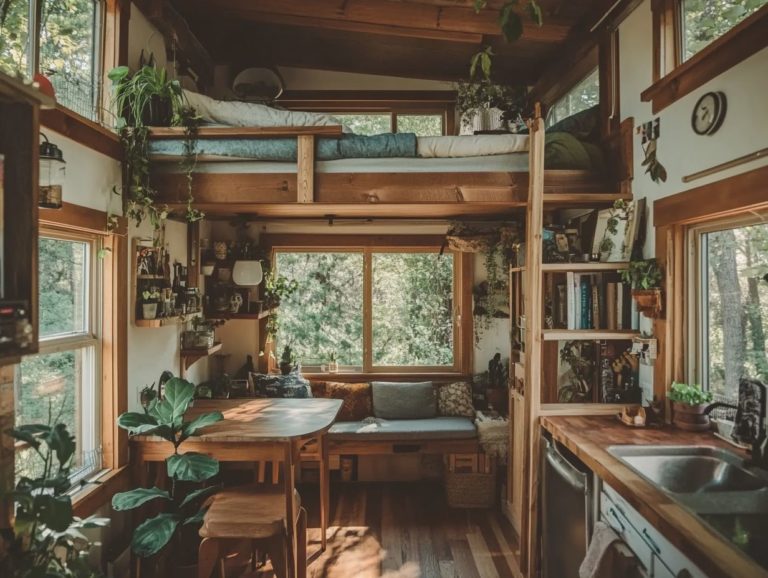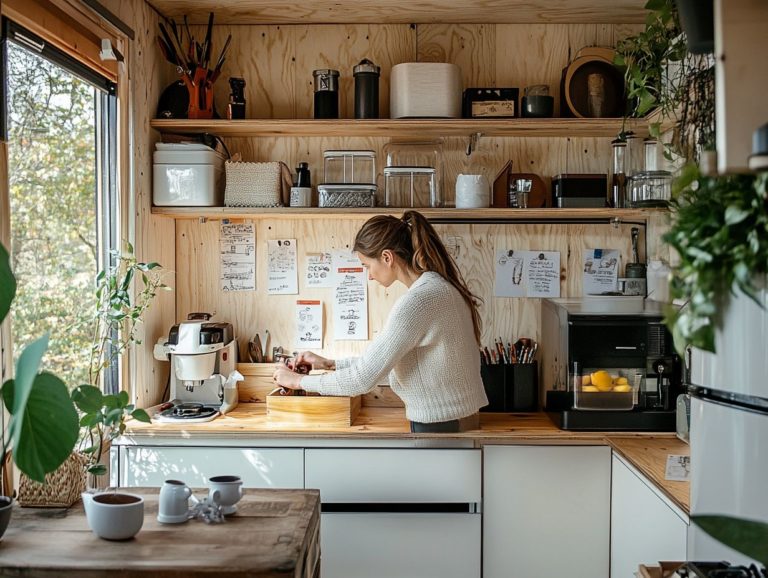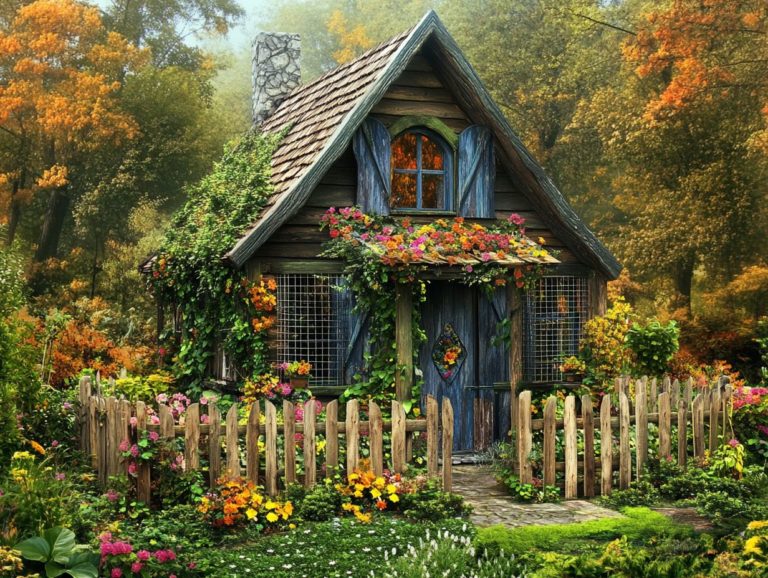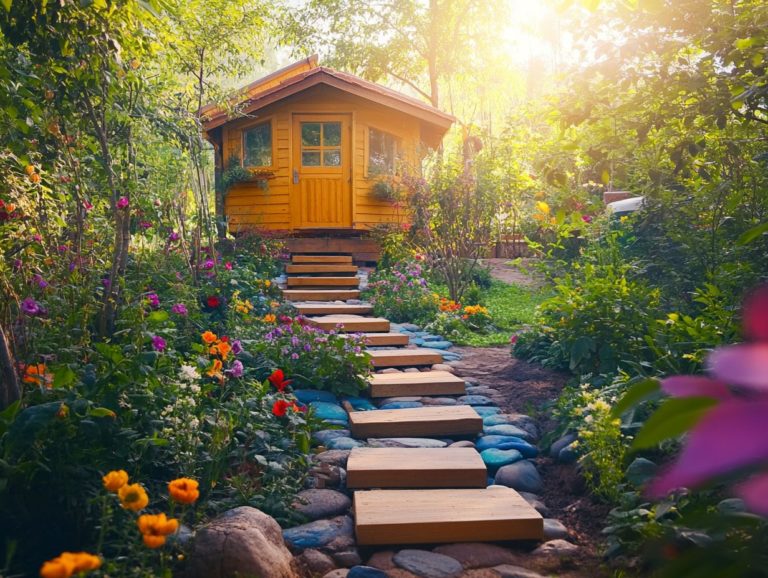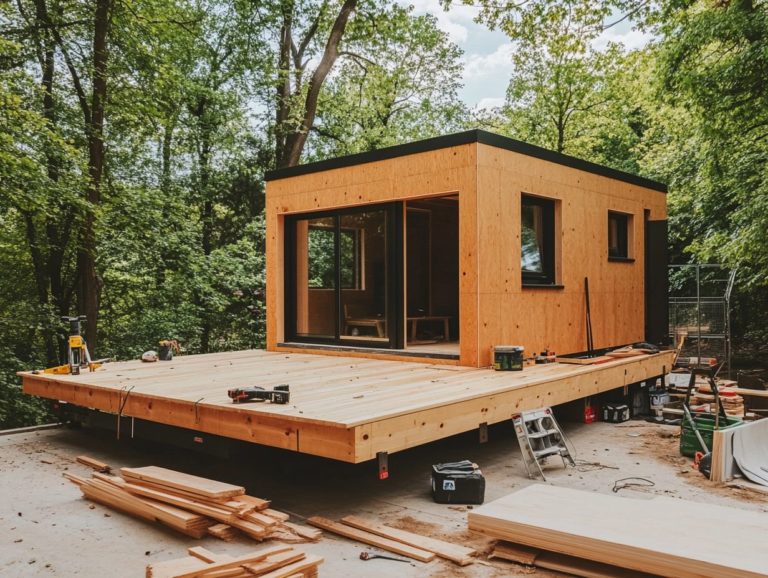Innovative DIY Tiny House Design Ideas
Imagine a cozy, sustainable living space that truly reflects your unique style. Your search ends here.
This article delves into a variety of innovative DIY tiny house designs that defy conventional living. From stylish shipping container homes to whimsical treehouse retreats, you’ll find creative ideas that not only maximize space but also embrace sustainability.
Whether you’re a seasoned DIY enthusiast or simply curious about the charm of tiny living, these options provide inspiration for all. Dive in and uncover how you can transform your living space in extraordinary ways!
Contents [hide]
- Key Takeaways:
- 1. Shipping Container Homes
- 2. Treehouse Retreats
- 3. Converted School Buses
- 4. Tiny House on Wheels
- 5. Earthbag Homes
- 6. Hobbit Houses
- 7. Yurt Dwellings
- 8. Converted Grain Silos
- 9. Floating Homes
- 10. Repurposed Train Cars
- 11. Straw Bale Houses
- 12. Tiny House Villages
- 13. A-Frame Cabins
- 14. Converted Shipping Pallets
- 15. Tiny House Boats
- Benefits of Building Your Own Tiny House
- Frequently Asked Questions
- What are some unique design ideas for building a DIY tiny house?
- How can I make my tiny house more eco-friendly?
- What are some space-saving tips for designing a tiny house?
- Can I still have a luxurious feel in a tiny house?
- What are some creative ways to add natural light to a tiny house?
- How can I personalize my tiny house design?
Key Takeaways:

- Get creative with unconventional materials like shipping containers and grain silos to build a unique tiny house.
- Embrace the beauty of nature by building a treehouse retreat or a hobbit house for your DIY tiny house.
- Maximize space in your tiny house by incorporating multifunctional furniture and storage solutions.
1. Shipping Container Homes
Shipping container homes represent a new way to live sustainably. They blend innovative design with eco-friendly practices.
By repurposing used shipping containers, you can create a modern aesthetic. This minimalist lifestyle suits both permanent residences and vacation rentals.
The affordability of these homes offers an accessible pathway into homeownership. This is especially true if you’re looking to downsize or simplify your life.
Customization options are plentiful. You can transform these containers with various layouts, colors, and styles to reflect your personal preferences.
Cities like Austin, Texas, and New Ipswich, New Hampshire, have experienced a surge in inventive container home projects. These projects showcase designs that seamlessly blend into their communities.
This trend aligns beautifully with the tiny house movement, promoting sustainable living without sacrificing creativity or comfort.
2. Treehouse Retreats
Treehouse retreats provide you with a whimsical escape into nature. These unique havens invite you to experience the magic of tiny living high above the ground.
Soak in breathtaking views of stunning landscapes. Crafted with eco-friendly materials and innovative designs, they serve as perfect vacation homes or backyard rentals.
Styles range from rustic cabins to sleek modern minimalist structures. You can find a treehouse that perfectly aligns with your aesthetic preferences.
Many designs embrace sustainable practices. They incorporate reclaimed wood and solar panels to enhance energy efficiency.
For example, in the Catskills, treehouse rentals often boast cozy interiors. These interiors beckon relaxation amid spectacular natural surroundings.
In Iceland, treehouses seamlessly blend into dramatic landscapes, showcasing the beauty of the land itself.
These retreats offer incredible comfort and charm, making every moment feel special! They also encourage a deeper connection to the environment, reinforcing the philosophy of sustainable living through their space-saving designs.
3. Converted School Buses
Converted school buses embody the essence of the tiny house movement. They transform once-functional vehicles into charming mobile tiny homes that celebrate space-saving designs.
These innovative dwellings invite you to embrace a unique lifestyle, where travel meets comfort through thoughtfully designed interiors.
The conversion process is a delightful blend of creativity and practicality. Every inch is carefully crafted to maximize functionality.
You ll often find multi-purpose furniture, like foldable tables and convertible sofas. This enhances utility without compromising on style.
In regions such as the Pacific Northwest and Southern California, converted buses are all the rage as trendy vacation rentals. They offer rustic charm paired with modern amenities.
Some enthusiasts even take the plunge and make these buses their permanent residences. This decision embeds them in communities that prioritize sustainability and minimalism.
This fosters a sense of belonging within the tiny living movement, making it not just a lifestyle, but a vibrant community.
4. Tiny House on Wheels
Tiny houses on wheels offer the ultimate freedom to embrace a minimalist lifestyle. You can explore breathtaking landscapes and unique destinations. These eco-friendly homes are thoughtfully designed to provide all the comforts of traditional residences. They feature clever storage solutions, compact appliances, and innovative designs that maximize every precious inch of space.
These dwellings grant you unparalleled flexibility in your living arrangements. Imagine easily moving your home wherever adventure calls! Whether you find yourself lounging by a serene lake or parked at a majestic mountainous retreat, you can effortlessly relocate your home to match your desired environment. This ability to travel while maintaining a home base opens the door to a nomadic lifestyle that perfectly caters to your adventurous spirit.
Imagine design elements like foldable decks or expansive windows that seamlessly integrate outdoor living. These features foster a deep connection with nature and create cozy spaces for relaxation and fun. This not only enriches your daily life but also transforms every moment into a celebration of the beauty around you.
5. Earthbag Homes
Earthbag homes offer a sustainable and innovative design alternative. They embrace construction methods that are simple yet profoundly effective in reducing environmental impact while enhancing energy-saving features. Crafted from natural materials, these compact dwellings showcase distinctive aesthetics and provide cozy living spaces that harmoniously blend with their surroundings.
The construction process involves filling durable bags with earth or other locally sourced materials. These bags are then stacked and tamped down to create strong, resilient walls. This technique bolsters their structural integrity and guarantees excellent thermal regulation, which means they keep your home warm in winter and cool in summer making them perfectly suited for a variety of climates.
Take, for example, the builders in New Paltz, New York, who have wholeheartedly adopted earthbag construction. They create eco-friendly residences that resonate with the tiny house movement. This approach promotes reimagining spaces in tiny house living without compromising on comfort.
Such architectural designs do more than just reduce carbon footprints; they encourage communities to seek out sustainable alternatives to traditional building methods. This inspires a shift towards a more eco-conscious way of living.
6. Hobbit Houses
Hobbit houses, inspired by the enchanting world of fantasy literature, offer a whimsical yet practical approach to tiny living. With their earth-sheltered designs, these homes blend seamlessly into stunning landscapes, creating an eco-friendly oasis that champions sustainability. You’ll find that they often use natural materials and sustainable practices, crafting unique living spaces that promote a deep sense of environmental stewardship.
Featuring signature curved architecture, these cozy lofts provide an inviting atmosphere that stands in stark contrast to conventional boxy designs. The rounded walls not only elevate the aesthetic appeal but also enhance thermal efficiency. This makes them perfect for year-round living or as delightful vacation retreats.
The natural insulation from the earth that envelops these structures keeps them warm in winter and refreshingly cool in summer. This makes them an ideal choice for innovative backyard rentals, allowing you to create charming and functional spaces for guests while infusing a touch of fantasy into your everyday life.
Don’t miss out on the chance to experience the charm of a Hobbit house!
7. Yurt Dwellings
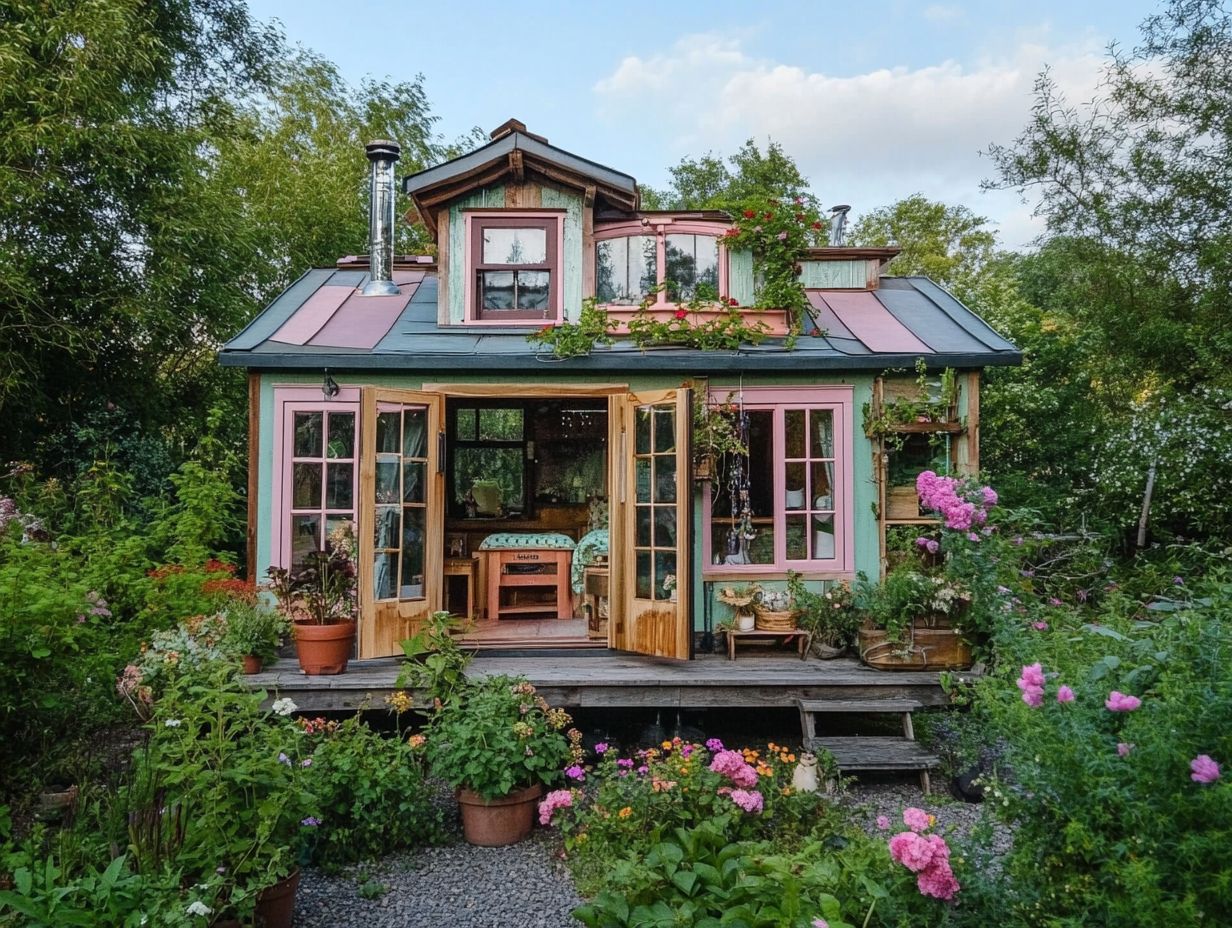
Yurt dwellings blend tradition and modernity in tiny living. They create cozy spaces that connect you to nature and promote sustainability.
Yurts originated in Central Asia. Nomadic cultures used their lightweight, sturdy design to survive harsh climates.
Today, yurt communities are growing worldwide. They foster camaraderie among tiny house movement enthusiasts.
8. Converted Grain Silos
Converted grain silos transform abandoned structures into stunning tiny homes. They promote eco-friendly living and preserve history.
Converting silos involves extensive renovations. These blend modern comforts with rustic charm.
In Brazil, converted silos serve as eco-resorts, immersing vacationers in lush surroundings. In Canada, silo homes enrich rural landscapes, offering unique accommodations.
Every design choice, from repurposed materials to modern furnishings, shows a commitment to eco-conscious living. This keeps the structures’ historical significance alive.
9. Floating Homes
Floating homes provide a lifestyle that combines the charm of waterfront living with sustainability. These homes minimize their environmental footprint.
These homes resist flooding, making them smart choices as sea levels rise and weather patterns change. In cities like Amsterdam and Vancouver, floating residences draw tourists seeking adventure and tranquility.
These homes adapt to various environments. They enhance community appeal and deepen connections to the surrounding ecosystem.
With their ability to rise with changing water levels, floating homes offer a sustainable housing solution for our evolving climate. Discover the charm of floating living!
10. Repurposed Train Cars
Repurposed train cars offer a charming and unique living experience. They showcase innovative design and promote sustainable living practices.
These tiny homes can be customized to include modern amenities, creating cozy spaces that truly reflect your personality, all while remaining eco-friendly and space-saving.
You can creatively redesign the interior layout, often incorporating reclaimed materials and energy-efficient technologies. Transform vintage railcars into stunning homes that showcase your individuality through both decor and functionality!
For instance, in the scenic hills of Denver, train car homes have become popular retreats. They seamlessly blend rustic charm with contemporary comforts.
Meanwhile, coastal communities in California have embraced this trend. These structures capture local culture and history, with each converted train car telling a story of sustainable living while celebrating the nostalgia of rail travel.
11. Straw Bale Houses
Straw bale houses truly embody sustainable living with their eco-friendly materials and natural insulation. They craft tiny homes that are both practical and visually appealing.
You ll find that these structures offer a distinctive design that enhances energy efficiency while minimizing environmental impact. They are an excellent choice for homeowners who prioritize sustainability.
Building these homes is fascinating. Bales of straw are stacked to create walls. They are then adorned with plaster or other finishes, ensuring they stand strong against the elements.
This technique harnesses a renewable resource and delivers impressive performance keeping you warm during chilly nights and refreshingly cool in the heat of summer.
From the sun-soaked terrain of New Mexico to the verdant landscapes of the Pacific Northwest, various regions have embraced straw bale building techniques. These homes play a significant role in the tiny house movement, offering tiny house design ideas for families with kids as an affordable solution for those looking to downsize without sacrificing comfort or their commitment to sustainability.
12. Tiny House Villages
Tiny house villages offer a unique, community-oriented living experience. They bring together individuals who embrace the charm of small-space living while prioritizing sustainable practices and eco-friendly lifestyles.
These villages foster a genuine sense of community and belonging, sharing resources and supporting one another on your tiny living journey.
These villages also showcase innovative designs that maximize every square inch. You ll find communal areas perfect for social gatherings, lush gardens, and shared workshops that encourage collaboration and creativity.
For example, take the village in Woodstock, New York. Creatively designed tiny homes reflect the personal touch of their owners while harmonizing in a cohesive aesthetic that enhances the overall community vibe.
This delightful blend of individuality and shared purpose strengthens community bonds and exemplifies a growing movement toward more mindful and intentional living. It might inspire you to consider the many benefits of tiny house living for yourself.
13. A-Frame Cabins
A-frame cabins present a unique architectural style. They beautifully marry rustic charm with modern functionality, making them a sought-after option in the realm of tiny homes.
Their steeply angled roofs create a striking visual appeal and foster spacious interiors that exude an open and inviting atmosphere. This design is perfect for embracing outdoor living.
These design features significantly enhance the efficiency of the cabins. They facilitate natural ventilation and temperature regulation.
With ample windows flooding the interiors with natural light, you ll feel a seamless connection to the surrounding environment. Whether nestled in the majestic mountains of Colorado or perched along the serene lakesides of Michigan, these homes harmonize effortlessly with nature, inviting you to relish the beauty outside.
This integration fosters a lifestyle of tranquility, where the stunning landscape becomes an integral part of your daily experience. Each A-frame retreat becomes more than a house; it becomes your personal sanctuary!
14. Converted Shipping Pallets
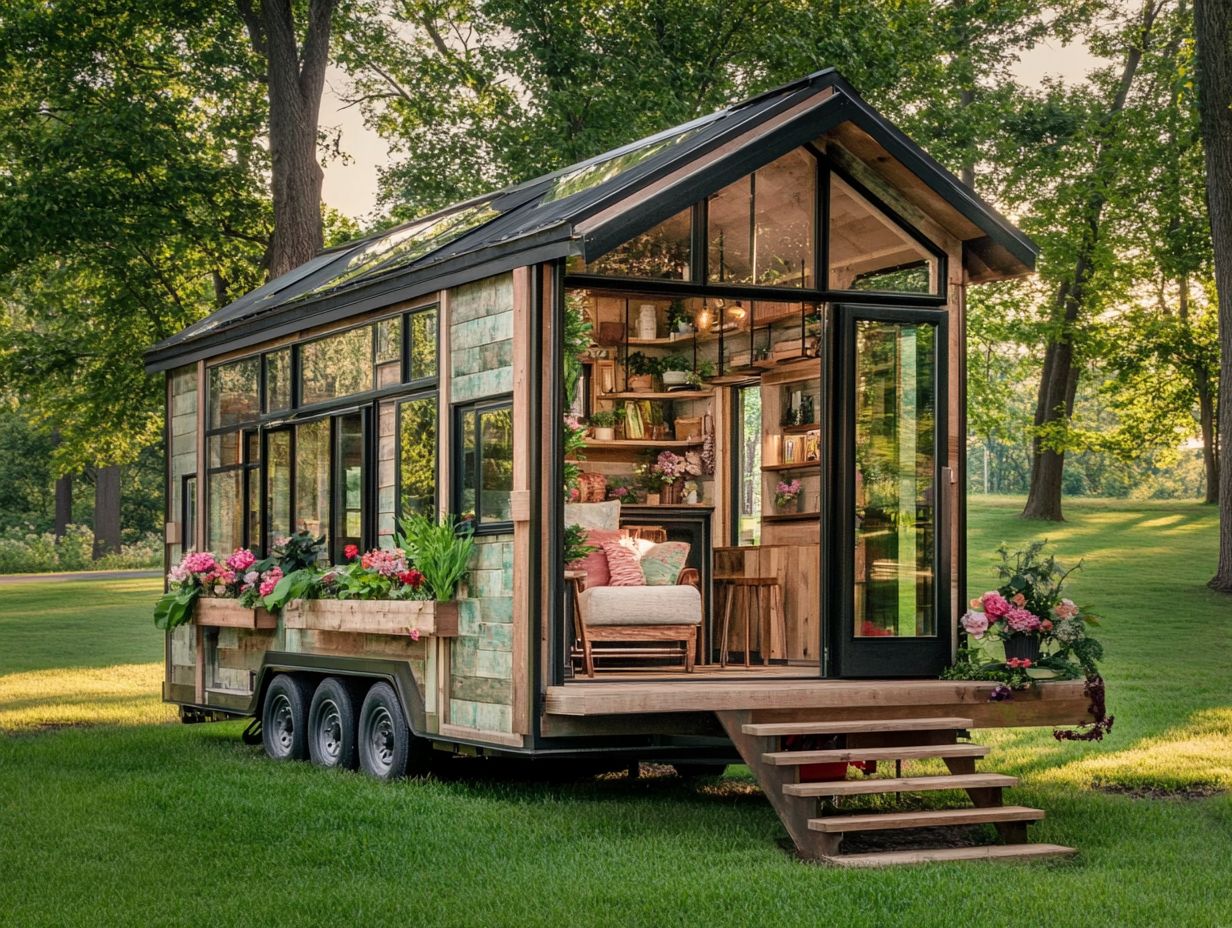
Converted shipping pallets offer you an affordable and eco-friendly pathway to crafting tiny homes that truly embrace the essence of sustainable living. These adaptable materials can be transformed into innovative designs that not only make the most of your space but also infuse character into a cozy living environment.
By utilizing pallets, you unlock a realm of creative possibilities as a DIY enthusiast, with countless options for both structural and aesthetic enhancements at your fingertips. Imagine crafting unique shelving units, partition walls, or even bespoke furniture pieces that perfectly reflect your personal style all while remaining mindful of your budget.
The tiny house movement has showcased remarkable examples of pallet-centric builds, where homeowners have elegantly woven these materials into their architecture, creating warm and inviting spaces. Many have eagerly shared their projects online, inspiring others to explore the vast potential of shipping pallets and discover smart design solutions for tiny house living.
15. Tiny House Boats
Tiny house boats seamlessly merge the charm of maritime living with the principles of the tiny house movement, providing you with amazing floating homes that offer all the comforts of modern life. These innovative designs maximize space and embrace outdoor living, allowing you to relish stunning landscapes from a refreshing perspective.
This lifestyle fosters a strong connection to nature, often leading to vibrant communities of like-minded individuals who share a passion for adventure and minimalism. Equipped with thoughtfully crafted amenities like compact kitchens, furniture that serves many purposes, and cozy sleeping quarters, these floating homes cater to your desire for sustainability and simplicity. Additionally, exploring the benefits of custom tiny house designs can enhance your living experience.
Popular spots for tiny house boating include the picturesque waterways of the Pacific Northwest and the coastal areas of Florida. Here, communities often come together to organize events and programs that celebrate this distinctive way of living.
As a resident of a tiny house boat, you ll discover joy in the freedom of mobility, exploring new waters while maintaining a home that truly reflects your values. Why not dive into this lifestyle and discover the freedom of life on the water?
Benefits of Building Your Own Tiny House
Incorporating home designs, unique materials, and innovative design ideas can significantly enhance your tiny house experience. Building your own tiny house unlocks amazing benefits, including the chance for personal expression, significant cost savings, and the ability to design a sustainable living space that perfectly aligns with your individual needs and preferences.
Engaging in the DIY process not only grants you creative freedom but also encourages the use of unique materials and innovative designs that truly reflect your personal style and environmental values. For inspiration, check out the top 10 tiny house interior design hacks. Constructing your tiny house in this way can greatly alleviate financial burdens, as you’ll sidestep the expenses associated with hiring contractors.
This financial freedom often ignites your creativity, allowing you to experiment with your space without the worry of overspending. The customization options available to you are virtually limitless, giving you the power to address specific lifestyle needs, whether it s mobility or integrating alternative energy sources (such as solar panels or wind turbines).
While you may encounter challenges, such as local zoning regulations or honing your construction skills, a plethora of online resources and community forums stand ready to offer invaluable support. By connecting with like-minded enthusiasts, you ll find a supportive community ready to share tips on sustainable practices and building techniques that resonate with eco-friendly living.
What Are the Challenges of Building a DIY Tiny House?
Building a DIY tiny house comes with its fair share of challenges. These include navigating limited space, understanding zoning regulations, and creating smart design ideas that balance functionality and comfort. While these hurdles may seem intimidating for first-time builders, thoughtful planning and a dash of creativity can help you overcome them.
A comprehensive grasp of budgeting is essential. Your financial plan often shapes the project’s scope and style. You’ll need to factor in costs for materials, permits, and any location-specific fees that may arise.
Effective planning goes beyond just having a solid blueprint. It also involves creating a timeline that accommodates construction techniques, ensuring tasks are executed in a logical sequence.
Leveraging resources like online forums, DIY workshops, and design software can yield invaluable insights and strategies. Connecting with seasoned builders can provide guidance and help you transform potential challenges into manageable steps. This ultimately leads you to the successful completion of a compact and functional living space.
How Can One Maximize Space in a Tiny House Design?
Maximizing space in your tiny house design requires a blend of creativity and strategic planning. Utilize clever storage solutions and modular furniture which can be rearranged or combined in different ways to craft living areas that are both functional and stylish. By incorporating multi-purpose items and innovative layouts, you can significantly enhance the comfort and usability of your small space.
One effective strategy is to integrate built-in furniture, such as benches with storage underneath or wall-mounted desks that fold down when needed. Consider using foldable tables and chairs that can be tucked away during downtime, freeing up valuable open space. Hidden storage solutions, like beds with drawers or ottomans that open up, add another layer of functionality.
Look to successful tiny house designs for inspiration, like the Tiny Mountain House, which showcases a clever combination of these techniques. This project proves that even the tiniest spaces can be beautifully efficient, especially with innovative storage solutions for tiny houses.
What Are the Essential Features of a Tiny House?
The essential features of a tiny house include innovative design elements, compact appliances, and a practical layout. These elements encourage a minimalist lifestyle while maximizing both comfort and functionality. They make sustainable living exciting and invite you to revel in the beauty of simplicity.
Energy-efficient appliances are crucial in this equation. They help reduce utility costs and shrink your carbon footprint, making sustainable living more accessible than ever. Clever storage solutions, like multifunctional furniture and built-in shelving, optimize space usage while ensuring your belongings remain organized and within reach.
Thoughtfully designed outdoor living areas extend your home. They provide perfect spots for relaxation or entertaining friends and family. Incorporating features like using recycled materials in tiny house designs elevates the tiny house experience, demonstrating that sometimes, less truly is more.
How Can One Incorporate Sustainable Practices into a Tiny House Design?
Incorporating sustainable practices into your tiny house design is crucial for minimizing environmental impact and embracing eco-friendly living. You can achieve this through innovative design choices, the selection of sustainable materials, and the use of energy-efficient technologies. This fosters a lifestyle that honors the planet.
One effective practice to consider is rainwater harvesting. It allows you to collect and store water for various uses, significantly reducing dependency on municipal systems. Integrating solar energy systems not only provides you with clean electricity but can also greatly lower your utility costs.
Tiny houses, like those crafted by EcoCabins, exemplify these methods. These homes feature roofs equipped with rainwater collection systems and solar panels that offer energy independence. For creative inspiration, check out innovative tiny house roof designs that demonstrate how using reclaimed materials can reduce waste while adding a distinctive aesthetic to your living space.
The benefits of such practices reach far beyond financial savings. They contribute to a sustainable community, inspiring others to adopt similar eco-conscious habits.
Start planning your tiny house today! Explore more about tiny house building and sustainable living.
Frequently Asked Questions
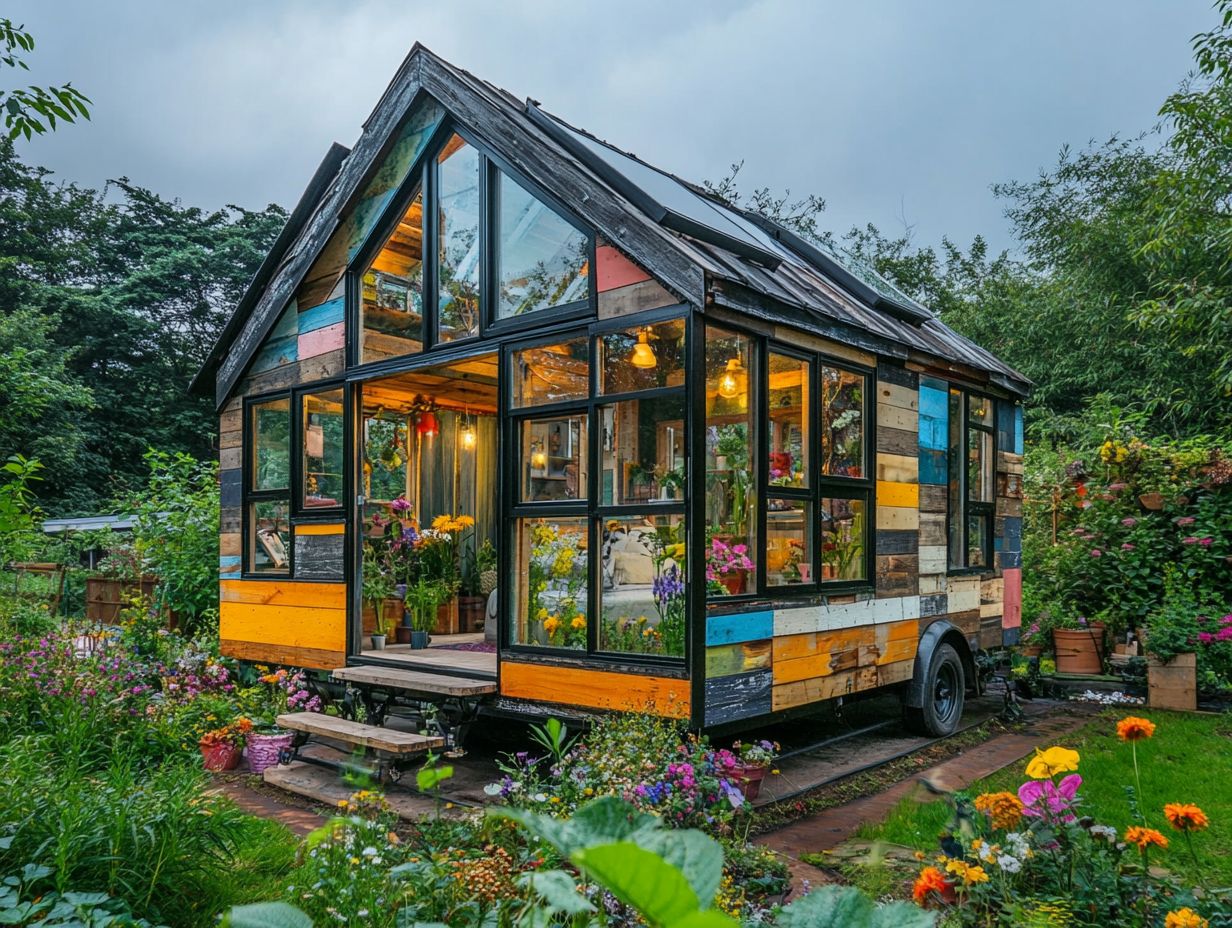
What are some unique design ideas for building a DIY tiny house?
Try using repurposed materials. Consider multi-functional furniture and vertical space for a smart design.
How can I make my tiny house more eco-friendly?
Install solar panels to make your tiny house more eco-friendly. Also, use energy-efficient appliances and sustainable materials.
What are some space-saving tips for designing a tiny house?
Maximize space with built-in storage. Incorporate foldable furniture and hidden compartments to keep things organized.
Can I still have a luxurious feel in a tiny house?
Absolutely! You can enjoy luxury in a tiny house. Think about high-end finishes like marble countertops and stunning chandeliers!
What are some creative ways to add natural light to a tiny house?
Add natural light with skylights and large windows. Glass doors and light-colored interiors can also help reflect light.
How can I personalize my tiny house design?
Incorporate your favorite colors and patterns to make it yours. Unique features like a rooftop deck or custom bookshelf can add charm.

